 |
|

|
 |
TABLE of CONTENTS
|
Agency commissioners tour MnDOT facilities, businesses across Minnesota |
By Laurie Ryan, Public Engagement and Constituent Services
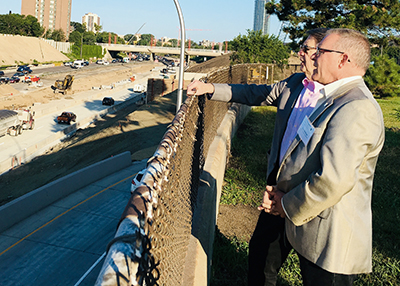
Scott McBride, Metro District engineer (foreground), and Ken Peterson, Department of Labor and Industry commissioner; view the 35W@94 project during Commissioner on Wheels tour July 31. Photo by Laurie Ryan |
The Minnesota Business First Stop Commissioners on Wheels took place July 31, traversing from the Twin Cities Metro District along the Interstate 94 corridor, to west central, Minn., and back. It was the seventh year for the tour of businesses around Minnesota.
Commissioners, other senior leadership and a staff representative from nine state partner MBFS agencies traveled on a bus as part of a 14-hour tour that began at 6 a.m. at the Metro District’s Waters Edge. The group of 26 traveled approximately 250 miles and interacted with businesses and civic leaders in four communities, toured four businesses and heard 12 presentations.
MnDOT played an active role on this full day road trip that kicked off with a group tour of the Regional Transportation Management Center Engineer led by Brian Kary, RTMC traffic management engineer. Then after boarding the bus, Metro District Engineer Scott McBride and West Area Manager April Crockett brought the group to a site overlooking the heart of the 35W@94 project, where Steve Barrett, the project construction engineer, met the group and gave a project overview.
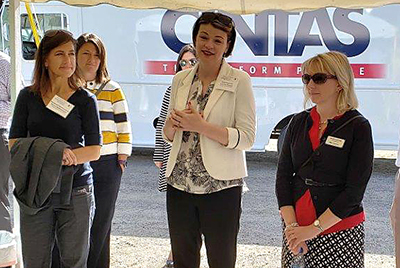
Nancy Daubenberger, assistant commissioner, Engineering Services, and Jody Martinson, assistant commissioner, Operations Division, are joined by Cynthia Bauerly, Department of Revenue commissioner, and Jessica Looman, Department of Commerce commissioner, on a business tour at Central Minnesota Renewables in Little Falls. Photo by Laurie Ryan |
The tour group traveled to Little Falls and toured both Central Minnesota Renewables and tractor trailer body builder Wabash National Corporation. Following a community luncheon at MnDOT’s St. Cloud Training Center that included a presentation by Project Manager Claudia Dumont, the group traveled to Sauk Rapids to tour Talon Industries, a manufacturer of precision machined products. The last business vivited was the new FedEx Ground facility in Rogers, followed by a business and community dinner held in Maple Grove.
In addition to McBride and Crockett, MnDOT staff on the bus tour included Assistant Commissioners Nancy Daubenberger and Jody Martinson; Assistant Operations Division Director Amr Jabr and Laurie Ryan, external relations liaison. |
 |
|

|
 |
TABLE of CONTENTS
 |
New white-topping project on Hwy 63 opens ahead of schedule with MnDOT "firsts" |
By Mike Dougherty, District 6 public engagement and communications
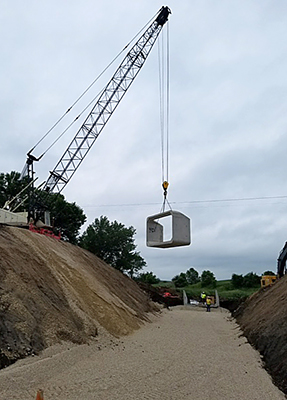
A large culvert replacement was part of the Hwy 63 project north of Rochester. Photo by Jim Koester |
MnDOT’s first 5-inch fiber reinforced white topping opened to traffic on Aug. 1 on Hwy 63 north of Rochester. The District 6 project marked several “firsts” as MnDOT continues to look for more efficient and betters ways to improve what it does and what it delivers.
The concrete overlay onto a milled 13-mile stretch of asphalt also marked one of the first times MnDOT used automated machine-guided milling, which was able to adjust the milling level automatically to keep it level. This allows the construction crew to make corrections to the pavement surface grades with the mill and pave with a consistent thickness of concrete. With conventional milling, grade corrections are made by varying pavement thicknesses, which requires the use of more concrete to make those corrections, increasing costs.
"What was most impressive to me was the coordination of Office of Materials and Road Research, the Concrete Office and the various district offices to make this happen in a short time period to produce a successful project that also produced good information MnDOT can learn from," said Kyle Lake, resident engineer for District 6 east construction.
The white topping, so named because it places a concrete layer on top of an existing road, is viewed as potential option for future overlays in certain circumstances. The 5-inch layer with fibers was believed to be the first time MnDOT has used this on a highway. It includes fibers to strengthen the pavement. The fibers were incorporated during the mixing of the concrete. MnDOT will monitor the pavement as years pass to assess its viability.
“We were pleased with how this project came together, and yet, no project is without challenges,” said Paul Schauer, District 6 construction project manager. “We were replacing culverts, detouring traffic, keeping access open for residents and businesses. The first-time use of the automated machine-guided milling and the fibers also challenged us to get it right.”
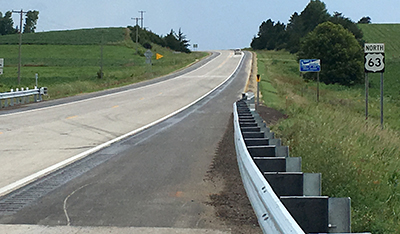
The Hwy 63 project north of Rochester opened to traffic Aug. 1. Photo by Anne Meyer |
During the design and public engagement portion of the project, District 6 project manager Heather Lukes emphasized the need to maintain access and the communication efforts. The challenge was how to reach approximately 80 businesses and individuals who live and work along the road. The concrete paving required both lanes of the two-lane highway to be closed for the concrete paver. Additionally, significant culverts were replaced, which forced residents to find different paths home on changing basis.
One resident along the route wrote to District 6 just after the project opened two days early: “I do want to thank DOT, District 6 for their great communications, and CROELL who was the primary contractor. Job well done! Finished two days early! They made the inconvenience very minimal. Great job all around.” |
 |
|

|
|

|
 |
TABLE of CONTENTS
 |
Rethinking I-94 team releases findings from two years of community engagement, research |
By Nick Carpenter, Metro District public affairs

MnDOT has engaged with the communities along the I-94 corridor between Minneapolis and St. Paul to establish future planning for the corridor. Photo by Nick Carpenter |
On a blistering hot day back in July 2015, Commissioner Charlie Zelle joined community members and elected officials on an empty city lot in the heart of St. Paul’s Rondo community. The commissioner publicly acknowledged past transportation practices that dismantled the once-thriving Rondo neighborhood and formally apologized, kick-starting an effort to “rethink” the way the department works with communities.
Three years have passed and the department is ready to share what it learned from engaging with Interstate 94 communities and researching the I-94 corridor between St. Paul and Minneapolis. MnDOT’s Rethinking I-94 team officially released the Rethinking I-94 Phase 1 report Aug. 1, detailing engagement activity and research conducted between January 2016 and August 2018.
Phase 1 of Rethinking I-94 focused on understanding the I-94 corridor and its communities. The team completed a wide range of engagement and technical tasks to help establish a foundation for future planning and project work on I-94.
“Through this effort, we wanted to go beyond looking at just the freeway and physical infrastructure around freeway," said Gloria Jeff, Rethinking I-94 project director. “This needed to be more about the people most affected by I-94, finding out how I-94 works for those who use it and live by it, and how the interstate affects their life on a daily basis.”
The team built what Jeff refers to as a “foundation” to lead the team into the second phase of Rethinking I-94.

|
Phase 2 — anticipated to begin in summer 2018 and last two years — will focus on developing a corridor-wide environmental document. This second phase intends to find agreement on actions that address transportation and transportation-related needs in the corridor.
MnDOT and local partners also may implement individual actions on or related to I-94. Through this phase, the team will continue to build relationships by engaging with communities along I-94.
“We need to keep the momentum going and bring our engagement efforts to the next level as we work on the environmental piece, and develop and evaluate alternatives for the corridor,” Jeff said.
To view the Rethinking I-94 Phase 1 report or an executive summary of the report, visit www.mndot.gov/I-94minneapolis-stpaul/vision.html. For more information on the Rethinking I-94 study, visit www.mndot.gov/I-94minneapolis-stpaul/. |
 |
|

|
 |
TABLE of CONTENTS
 |
District 6 Intelligent Work Zones study taps traffic data to inform motorists on I-35 |
|
By Mike Dougherty, District 6 public engagement and communications
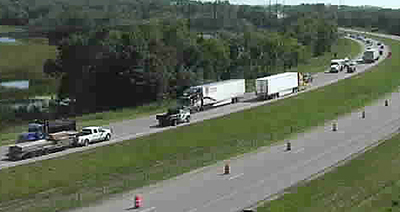
Photo from traffic camera along I-35 near Faribault. |
The software that helps produce the common drive time message signs on Twin Cities freeways is helping District 6 study how it might help make work zones safer.
An unbonded concrete overlay on southbound Interstate 35 at Faribault is the site for 16 message signs (nine for northbound traffic and seven for southbound traffic) with messages linked to traffic detectors set every half mile.
“It uses the same algorithm with the Intelligent Roadway Information System software that MnDOT wrote to provide motorists in a work zone with information that can make it safer and perhaps reduce some of the anger or anxiety when traffic is backed up,” said Adam Wellner, District 6 traffic design engineer.
D6 is using a mix of permanent changeable message signs with portable message signs that are linked to traffic detectors along the approximate 4-mile work zone where traffic is routed off the southbound lanes and into a single lane in the northbound lanes adjacent to the single-lane northbound traffic. Traffic backups and delays are common on weekends when the traffic numbers surge. It’s a work zone squeezed from four lanes to two lanes and an average daily traffic of 33,500.
Motorists will get a range of messages along the route depending on traffic flow. If traffic is slowing, but still flowing, motorists get a drive time message with an estimate of how many minutes to a road ahead, such as Hwy 19. If it’s slowed considerably, motorists get the message of “Slow Traffic Ahead,” while if it’s slowed to stop or near stop, it’ll be “Slow Traffic Ahead, Prepare to Stop.” If traffic is stopped within the work zone, motorists may get a message with the approximate drive time to the next exit, such as Hwy 21.
“When we can tell people what to expect, we generally get better driving decisions,” Wellner said. “Or if they’re in a delay, it can help them understand the real time of delay, not one that may tend to be over inflated in their minds. It might decrease road rage.”
Wellner said the data that will be culled from this study may lead to better predictions in how to model work zones, improve efficiency of devices and refine plans and specifications for projects. It’s part of a Minnesota study of the deployment of Intelligent Work Zones.
“It’s useful in learning how work zones operate and find ways to make things better,” Wellner said. “Maybe there’s not much else we can do while they’re in traffic, but maybe there’s something else such as enhanced public engagement in advance.”
The project started July 9 and stretches from Rice County Road 9 to Hwy 21 in Faribault. Shafer Contracting Co., Inc. of Shafer, Minn. is the prime contractor on this $8 million project.
Construction is expected to be completed in fall 2018. To learn more, go to the MnDOT construction project website.
To learn more about the range of construction projects along I-35 in Minnesota this season, go to www.dot.state.mn.us/metro/projects/i35corridor2018/. |
 |
|

|
 |
TABLE of CONTENTS
 |
Mark Schoenfelder named district engineer for District 6 |
By Mike Dougherty, District 6 public engagement and communications
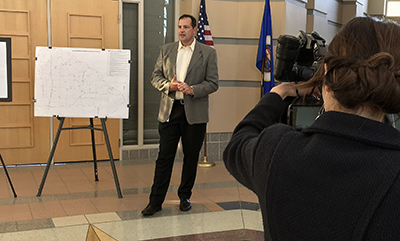
Mark Schoenfelder spoke to Rochester area media earlier this year about the 2018 construction kickoff during a joint event with the city of Rochester and Olmsted County. Schoenfelder was named the new district engineer in District 6 to replace Jeff Vlaminck, who retired after more than 41 years with MnDOT. Photo by Mike Dougherty |
Mark Schoenfelder has been named the new district engineer for the Minnesota Department of Transportation District 6.
Schoenfelder most recently was assistant district engineer for program delivery for District 6 in Rochester. He has been with MnDOT for more than 15 years. He began his new role July 30. Jeff Vlaminck, the district engineer since 2013, retired Aug. 1 after more than 41 years with MnDOT.
“Jeff's leadership guided us on a path to sustain success,” Schoenfelder said. “We have a strong, talented team, and I know we will continue to accomplish great things in our district and continue to serve the public. I think we have a culture at MnDOT and in District 6 that is similar to a family. I've experienced it and I want to promote that continued spirit.”
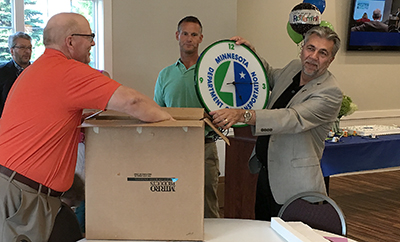
Jeff Vlaminck, who retired at the District 6 district engineer on Aug. 1, opens a gift from members of his district management team during a celebration event on Aug. 3 in Rochester. Also pictured are Steve Kirsch, left, assistant district engineer for program support and Mark Panek, center, assistant district engineer for west operations. Photo by Mike Dougherty |
Previously, Schoenfelder has also served as director of MnDOT’s Building Services for the Office of Maintenance as well as District 6 planning director and in professional and technical roles for the Right of Way and Survey areas in District 6. He has private sector experience focusing on the areas of client development, project management, site and facility development, and design.
“In addition to his years of experience, Mark brings strong leadership skills and has many established relationships within the District 6 communities,” said Jody Martinson, assistant commissioner, Operations Division.
Schoenfelder is a registered professional engineer and professional land surveyor, who has master’s degree from the University of Minnesota in Infrastructure Systems Engineering.
“With a strong District 6 team whose trademark is quality, hard work and skill, I am very confident that the district will continue to do great things with Mark at the helm,” Vlaminck said. |
 |
|

|
 |
TABLE of CONTENTS
 |
Not one, but six winners named in MnDOT's safety tagline contest |
By Sue Roe
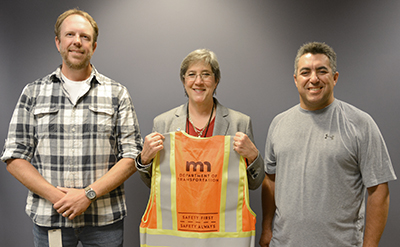
Two of the six winners of the safety tagline contest are Chris Dickrell, left, traffic management system integrator at Metro, and Michael Trujillo, right, transportation generalist senior at the Mendota Heights construction office. Sue Mulvhill, deputy commissioner, shows what the new tagline "Safety First, Safety Always" will look like on the new safety vests. Photo by Sue Roe |
Safety First, Safety Always. That’s MnDOT’s new safety tagline, thanks to the creative minds of six employees. The statewide Safety Culture Improvement Advisory Team launched its safety tagline contest in May and employees submitted 430 taglines for consideration.
“I was thrilled about the number of entries,” said Rod Starkey, safety culture program coordinator. “This many entries shows how much employees value safety and how important safety is to the agency. We appreciate all the employees who took the time to submit their ideas.”
The six winners are from four different districts. They are Cory Thompson, transportation generalist in District 2; Michael Trujillo, transportation generalist senior at the Mendota Heights construction office; Chris Dickrell, traffic management system integrator at Metro; Steve Kotval, transportation generalist in District 3, Dana Dabbert, transportation generalist in District 4 and Brad Scott, administrative manager in District 2.

Other winners of the safety tagline contest include Brad Scott, administrative manager in District 2; Dana Dabbert, transportation generalist in District 4; Cory Thompson, transportation generalist in District 2; and Steve Kotval, transportation generalist in District 3. Photos courtesy of their respective disticts |
These employees submitted either the exact tagline wording or something so similar that the advisory team decide to name six winners instead of one.
Starkey said MnDOT hasn’t had a statewide safety slogan since the 1980s.
“We have a safety creed we use, but it’s long and hard to remember,” said Starkey. "We wanted something that was three or four words and that would resonate with everyone. We think this new tagline says it all about where our safety culture needs to be.”
The new tagline will be used on safety vests the districts order. Last year, the agency ordered more than 2,300 vests. The tagline will also be used on hats, posters, banners and other items.
Kotvalt, who has worked at MnDOT for two years, said he entered the contest because the tagline idea popped into his head from his 12 years serving on the safety board at the Minnesota Department of Corrections.
“We have to look out for each other so we all go home at the end of the day,” said Kotvalt. “We need to teach each other about safety and have each other’s backs.”
Trujillo, who is a road and bridge inspector, said he submitted ideas because safety is what employees in the field think about all the time.
“It’s what we all worry about,” he said. “There’s no reason we can’t take the time to do something right.”
Dickrell said his two young daughters helped him with his winning entry.
“I told them safety is something we work with every day. Everyone was throwing out ideas,” he said. “The kids were excited when I told them we won.” |
 |
|

|
 |
TABLE of CONTENTS
 |
What's new on the web |
MnDOT’s data warehouse
MnDOT’s data warehouse now has a presence on iHub. If you have ever wondered about what is inside the warehouse or how you can access warehouse data, you can now learn more on the data warehouse website. The new page contains basic descriptive information about the MnDOT data warehouse and provides additional reference sources and contact information for interested data consumers.
|
 |
|
| |
|



